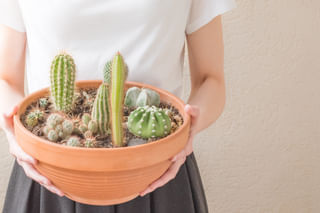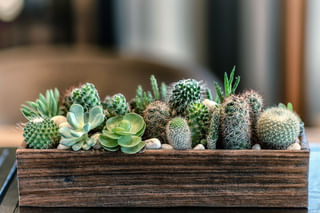How to take care of an indoor cactus
Are you wondering how to water a cactus, what type of light a cactus needs, or if you can put your cactus outside in the summer? This guide contains everything you need to know about taking care of a cactus!

Did you just get a cactus or are you thinking of getting one? Cacti are a great choice for plant owners who are looking for a low-maintenance plant for their living space. Cacti are especially great plants for beginning plant owners because they need very minimal care. With just a little bit of care, your cactus can thrive indoors.
In this plant care guide, we're going to look at everything you need to know about taking care of an indoor cactus. With these easy-to-follow plant care tips, you'll help your cactus thrive in your home, so you can enjoy your plant for many years!
These are the topics we're going to look at:
After you've finished reading this plant care guide, you'll have all the information you need to take care of your cactus and help it stay healthy for many years to come. Let's get started!
How often do I need to water my cactus?
Watering your cactus is one of the most important aspects of cactus care. You want to make sure that you provide your plant with enough water without overwatering it, as this can cause root rot and other issues.
How often you need to water your cactus depends on the type of cactus, the size of the pot, and the environment in which it is growing. Generally speaking, most indoor cacti should be watered only once every 2 to 4 weeks during the growing season: usually in spring and summer. It's important to let the soil dry out completely in between watering them, as cacti are sensitive to overwatering and thrive in dry soil.
Watering in the winter
In winter, most cacti will go dormant and need much less water, you'll only have to water them once per month. To tell if your cactus needs water, simply poke your finger into the soil and see if the soil is dry. If it is, you can water your cactus again.
When watering your cactus, make sure to use lukewarm or room-temperature water. If you use cold or hot water, you might shock the cactus' roots and this could kill the plant. Water thoroughly until the soil is damp all the way through. If you're using a pot with a drainage hole, you should let any moisture drip out of the bottom of the pot for about 5 minutes. This helps to remove any excess water from the pot, as standing water can cause root rot and fungal diseases.
If you're unsure on how to water your cactus best, have a look at Watering techniques for Cacti.
What kind of light does a cactus need?

Cacti naturally grow in warm and dry areas, usually in deserts. In its natural habitat, a cactus is getting strong, direct sunlight all day long. So if we want to help our cactus to thrive, we'll need to give it a similar environment to the desert: lots of sunlight and warm temperatures.
The perfect spot for your cactus is in a spot where it gets direct sunlight: near a south or west-facing window. Indirect sunlight will also work, but be sure it's in a spot that gets bright light for at least 6 hours per day.
For the best result, you should also rotate your cactus regularly so that all sides of the plant are exposed to the light evenly. Rotating your cactus has 2 reasons: it helps your cactus get enough light, but it also helps to prevent your cactus from growing to one side if it's never rotated.
Indirect sunlight for some cacti
Some cacti, especially those with very thin leaves, will do better in spots where they get bright but indirect sunlight. These cacti aren't as tough as the thicker cacti and could get sunburns from direct sunlight. If you're unsure whether your cactus should be in direct or indirect sunlight, give it the brightest spot you can find where it's not getting any direct sunlight during the day.
What temperature range is ideal for indoor cacti?
Indoor cacti generally thrive in temperature ranges between 21 and 32 degrees Celsius (70 to 90 F) during the day. At night, they can tolerate temperatures as low as 10 degrees Celsius (50 F).
It's important to avoid sudden temperature drops and maintain steady conditions to keep your cacti healthy. Keep your cacti away from air conditioning units, heaters, and drafty windows and doors to avoid sudden temperature changes that could shock your plants.
Acclimating a cactus to changes in light or temperature
Sometimes there is no way around it, you'll have to move your cactus to a new spot with different temperatures and different light. Most plants don't like to be moved and love consistent temperatures. So for the best success and to avoid stressing your cactus, you need to make this change slowly. Here's how!
Light acclimation
- Move it slowly: If you're moving your cactus to a brighter location or outdoors, start by placing it in a partially shaded area. Increase its exposure to direct light gradually over 1-2 weeks.
- Keep an eye out for stress: Plants can get stressed when handled, so make sure to watch for signs of sunburn or stress, such as yellowing or browning spots on the cactus. If these appear, slow down the acclimation process.
Temperature acclimation
- Move it slowly: When you're moving your cactus to a spot with a new temperature range, do so slowly. For example, if moving it from indoors to outdoors, start with a couple of hours outside and increase over several days.
- Stable conditions: Make sure that the night-time temperatures aren't too different from what the plant is used to. Sudden drops can stress the plant.
- Protect during extremes: During extreme temperatures (either very hot or cold), make sure to protect your plant. You can use shade or obstacles to protect it from hotter and colder temperatures.
The key to acclimating your cactus, as you saw, is to do this slowly. By doing this slowly, you give the cactus a change to get used to its new environment, bit by bit. This helps to prevent stress.
What is the ideal humidity range for cacti?
While cacti are famous for thriving in dry conditions, it's important to know the ideal humidity levels for different types to keep them healthy. Typically, keeping humidity low mimics their natural desert homes and helps avoid problems like rot and fungal diseases.
Here are the ideal humidity levels for different types of cacti:
Desert cacti
These cacti love a humidity level between 10% and 30%. They thrive in dry air and don't need extra humidity, making them perfect for regular indoor spaces where the air tends to be pretty dry.
Tropical and epiphytic cacti (e.g., Christmas Cactus, Easter Cactus, Orchid Cactus)
These cacti thrive best in humidity levels of 50% to 60%. Originating from tropical or subtropical areas, they like a bit more moisture than your typical desert cacti. They can handle lower humidity, but you might need to water them more often or give them a little mist now and then to keep them happy.
Managing humidity around your cacti
To keep your cacti happy, it's important to manage indoor humidity levels. If the air is too humid for desert cacti, grab a dehumidifier. On the flip side, if you've got tropical or epiphytic cacti and the air feels dry, a humidifier or a tray of water nearby can help out.
Also, be careful not to overwater; high humidity plus too much water can cause root rot and mold problems, so make sure the soil dries out between waterings, especially for those desert varieties.
Good airflow around your cacti is key, too, to avoid stagnant air that can ramp up humidity and lead to mold growth.
What is the best potting soil for cacti?
We've already looked at the two most important parts of taking care of a cactus: Sunlight exposure and watering it properly. However, a close third important topic is its soil.
When choosing a potting mix for your cactus, choose one that is specifically designed to be used with succulents and cacti. These soil mixes contain ingredients like peat moss, perlite, pumice, sand, and composted bark. These ingredients make the soil drain moisture to the bottom of the pot very quickly, so minimal excess water stays behind in the pot. The cactus thrives in a dry environment after all.
I mentioned in the section about watering that any excess water will drain to the bottom of the pot. If the excess water stays in the pot it could cause root rot, so it's important to let this excess water drain from the pot. The best way to do this is to always use a pot with a drainage hole in the bottom. This helps prevent root rot and other issues caused by overwatering. You can also add a little gravel to the bottom of the pot, as this prevents the soil from falling out of the pot too easily.
Should I fertilize my cactus?
Most cacti are slow-growing plants, you're lucky if you see significant growth during the growing season. Like most other slow-growing plants, fertilizing isn't necessary. Your cactus will absorb the nutrients from the soil when you water it, which is plenty to help it stay healthy.
However, if you'd like to help your cactus grow a little bit more quickly, you can. If you want to fertilize your cactus, look for a fertilizer specifically designed for succulents and cacti. These fertilizers are typically high in phosphorus and potassium, which are important nutrients for healthy cacti growth.
The best fertilizer to use for a cactus is a liquid fertilizer, which you add to the water when you water your plant. Your cactus can absorb these nutrients more easily and you can control the strength of the fertilizer much more easily.
In general, most cacti only need to be fertilized once every three months during their growing season: once at the beginning of spring and once at the beginning of the summer. During the winter, when your cactus goes dormant, you shouldn't fertilize it.
Even if you decide not to give your indoor cactus any fertilizer at all, it should still stay healthy as long as it gets the sunlight and water it needs. The cactus is an easy-going plant when it comes to fertilizer.
Pruning a cactus

You can prune your cactus to manage its size, shape, and health. Pruning can help remove damaged or diseased parts and encourage new growth. Here's a step-by-step guide on how to prune your cactus:
Before you start
The best time to prune your cactus is late spring to early summer when it's actively growing. Just be sure to skip any trimming during the winter since that's when the cactus is dormant.
You'll need a few handy tools: a sharp, sterilized knife or pruning shears for clean cuts, some thick gloves to protect your hands from those pesky spines and sap, and tongs if you're dealing with smaller cacti or ones with really dense spines. Oh, and don't forget a disinfectant like alcohol or a bleach solution to clean your tools before and after use!
Steps for pruning
Here's how you successfully prune your cactus:
- Examine the cactus: Identify areas that need pruning, such as overgrown sections, damaged or diseased parts, and offsets (pups) if you want to propagate them.
- Sterilize tools: Clean your knife or pruning shears with alcohol or a bleach solution to prevent infection.
- Protect yourself: Wear thick gloves to avoid injury from the cactus spines.
- Make clean cuts:
- Overgrown sections: Cut segments just above where they join the main stem. For large columns or pads, cut at the joint or node.
- Damaged/diseased parts: Remove these sections entirely, cutting into healthy tissue to ensure no diseased parts remain.
- Offsets (pups): Gently twist or cut the pups away from the base. Allow the cuts to callous over before planting.
- Allow it to heal: Let the pruned areas dry and callous over for a few days to a week. This reduces the risk of infection when watering.
- Optional propagation: If you've removed healthy segments or pups, you can propagate them. More on this in the next section!
Post-pruning care
After you prune your cactus, it's best to hold off on watering for a bit to let those cuts heal. Keep an eye out for any signs of rot or infection and take action if you notice any problems. And don't forget, making sure your cactus gets enough light is key for healthy growth and recovery!
How can I propagate a cactus?
Propagating a cactus is a great way to get more of the same plant for free. Who doesn't love free plants? Luckily, propagating cacti is quite easy to do!
Propagate using cuttings
When you're propagating your cactus from a cutting, select a healthy, mature stem from the cactus that has at least two or three small buds or areoles on it (these are the small bumps where spines come out). Cut the stem just below one of the areoles, making sure it's at least 5-7 cm (2-3 inches) long.
After taking the cutting, you should let the cut end dry in an airy and warm location for two or three days before planting it in a pot of well-draining soil.
Make sure you use a pot with drainage holes at the bottom and that it's large enough for your cutting to fit comfortably. This means that it should have around 2-3 cm (1 inch) of space around it.
After you've planted your cutting, water it lightly and place it in an area where it will get plenty of bright light but not direct sunlight. The cutting isn't strong enough to handle direct sunlight yet.
Why should you let the cutting dry out?
When you let the cutting dry out for 2-3 days, you're much more likely to propagate your cactus successfully. If you were to put your cutting into the soil right after removing it from the parent plant, you run the risk of infecting your cactus cutting with diseases or bacteria. This often kills the cutting, so your propagation won't be successful.
Propagate by using offsets
If you want to propagate by offsets instead, wait until your cactus has grown several new "babies". The baby cacti will grow out of the base of the parent cactus. Gently twist each offset off its parent plant without damaging the roots and place them on top of well-draining soil in individual pots.
Water these propagated offsets a little bit at a time, to prevent the soil from staying wet for too long. Once the offsets have adjusted and have grown more roots in their new pot, you can water it as if it were a fully-grown cactus.
It might take a while before your new cactus starts to grow, but this is normal: cacti usually don't grow very quickly anyway.
How do I repot my cactus when it outgrows its current pot?
Photo by Teona Swift
Repotting your cactus is crucial for maintaining its health and promoting robust growth. When a cactus becomes root-bound or outgrows its current pot, it can struggle to absorb nutrients and water efficiently. Regular repotting ensures that your cactus has ample space for its roots to expand, helping it thrive in its environment.
Gather the materials
- New pot with drainage holes (one size larger than the current pot)
- Cactus or succulent soil mix
- Thick gloves or tongs
- Newspaper or old towel for handling the cactus
- Small brush (optional) to clean the cactus
Wait for the right time
The best time to repot your cactus is from late spring to early summer, when it's actively growing. Just avoid doing it in the winter when the cactus is dormant.
Prepare the new pot
Make sure your new pot has drainage holes, then fill the bottom with a well-draining cactus or succulent soil mix.
Remove the cactus from the old pot
To protect yourself, wear thick gloves to avoid getting pricked by spines, and you can even wrap the cactus in newspaper or an old towel for extra safety. Gently tap the sides of the pot to loosen the soil, then carefully lift the cactus out. If it's stuck, use a blunt knife or trowel to loosen the edges.
Inspect the roots
First, take a look at the roots to make sure they're healthy and not showing any signs of rot or disease. Healthy roots should be white or light tan. If you spot any dead or rotten roots, just trim them off with some sterilized scissors or pruning shears.
Place the cactus in the new pot
Position the cactus in the center of the new pot, making sure it stands upright. Then, add the cactus soil mix around the roots, pressing down gently to secure the plant. Leave a bit of space at the top for watering.
Allow to settle
Let the cactus sit in its new pot without water for about a week. This allows any damaged roots to callous over and reduces the risk of root rot.
First watering
After the drying period, water the cactus lightly. Gradually resume the normal watering schedule based on the cactus's needs.
Post-repotting care
Place your repotted cactus somewhere with the right light for its type, and keep an eye on it regularly for any signs of stress or adjustment issues.
How big will my cactus get?

You might have seen giant cacti before, but also tiny ones. So you might be wondering how large your cactus can grow indoors. Unfortunately, there is no clear answer, as there are very many different types of cacti out there. Some stay small, while others can grow as large or as tall as your house.
It depends on the type
The size of your cactus depends a lot on the type and species. Smaller types such as Christmas cacti and Bunny Ear cacti tend to stay quite small. When they're fully grown, they generally don't get taller than a few feet. On the other hand, larger types like Golden Barrels and Saguaros can quickly become quite tall. Some of them can even reach heights of up to 20 feet!
Luckily you can help some of the bigger cacti to stay smaller if that's what you want. For example, if you're growing your cactus in a small pot with very little space to spread out and grow, your cactus won't grow past a certain height.
However, you can also help some of them to grow larger if that's what you want. If you're fertilizing your cactus throughout the growing season and watering it perfectly, your cactus will grow slightly faster and bigger than one that is always dry and doesn't receive a lot of care.
Can I put my cactus outside in the summer?
When you've got a nice cactus and it's a little warmer outside during the summer, you might be wondering if you can bring your cactus outdoors to enjoy the sun! The short answer is: Yes, you can put your cactus outdoors during the summer months, but only if you live in an area where the cactus can survive during the summer.
For your cactus to survive outside during the summer, it should be able to handle temperatures ranging from 7 to 35 degrees Celsius (45 to 95 F). Even if the temperatures are perfect for your cactus, it's best to keep it protected from strong winds and direct sun-especially during the hottest hours of the day.
Before you bring your indoor cactus outdoors for the summer, make sure you acclimate it to its new environment gradually. Begin by putting the plant outside in partial shade or indirect sunlight and eventually move it into the full sun over several weeks. By moving your cactus outside and letting it acclimate, you'll help your cactus adjust to its new environment and avoid shock, sunburns, or other damage.
Helping a cactus bloom indoors

Cacti can bloom indoors if they have the right growing conditions, but don't get excited too quickly. Making a cactus bloom indoors is much more difficult than making it bloom outdoors, unfortunately. You'll need to give it the "perfect" care for years, before you can enjoy the fruits of your labor.
Here are some key factors to consider for encouraging your cacti to bloom indoors:
To keep your cactus happy and thriving, make sure it gets plenty of bright, indirect light-ideal spots are near south or west-facing windows. During spring and summer, they love warm temps, so aim for around 21 to 32 degrees Celsius (70 to 90 F) during the day and a bit cooler at night. Don't forget to water regularly while the cactus is growing, but let the soil dry out completely between watering sessions. In winter, cut back on watering since they prefer a cool dormancy period.
When it comes to soil, use a well-draining cactus mix to avoid root rot, and always pick pots with drainage holes. Cacti thrive in low-humidity spots, so steer clear of humid areas like bathrooms. As for feeding, a balanced, diluted fertilizer every 4-6 weeks during the growing season works wonders, just remember to choose one that's low in nitrogen. Lastly, be patient-some cacti can take years to bloom, so stick to a consistent care routine for the best results!
Common Indoor Blooming Cacti
To get the best chance of having your cactus bloom indoors, be sure to pick up one of these cacti:
- Christmas Cactus (Schlumbergera spp.)
- Easter Cactus (Hatiora gaertneri)
- Parodia
- Mammillaria
- Rebutia
These will have the highest chance of blooming indoors.
How do I know if my cactus is sick or not?
Sometimes your plants start to look a little different and you might wonder if you've done something wrong or if the plant is doing okay. That's normal and is something every plant owner goes through, even if you've taken care of plants for many years.
Look for signs of growth
So how do you know if your plant is sick or not? One of the easiest ways to tell if your cactus is healthy or not is to look for signs of growth. A healthy cactus grows and blooms throughout the year, so if yours isn't doing either of those things, it might be telling you there is a problem.
Look for visual symptoms
Other common signs that a cactus is sick include wilting leaves, black spots on the skin, indented areas where the flesh appears to be rotting, and excessive amounts of sap seeping from cuts in the skin.
If you think your cactus is sick or has been infected with a virus or fungus, take it to a local nursery or garden center to ask for help on what to do. You can often still save your cactus if you spot the issues quickly.
You can also ask for help in our Facebook group! The community is very friendly and is always happy to help you figure out what's wrong with your plant!
Common pests that can affect cacti
Like most other plants, there are several common pests can affect cacti. Knowing how to identify and deal with these pests is important to keep it healthy long term. Here are some of the most common cactus pests and how to manage them:
Mealybugs
Mealybugs are small, white, cotton-like masses on the cactus. This is how you can treat them:
- Remove them by hand: Use a cotton swab dipped in rubbing alcohol to remove mealybugs.
- Insecticidal soap: Spray the cactus with insecticidal soap, following the product instructions.
- Systemic insecticides: For severe infestations, consider using systemic insecticides.
Spider Mites
Spider mites look like tiny red or brown mites and fine webbing on the cactus. Treat them using one of these methods:
- Water spray: Use a strong stream of water to wash off mites and webbing.
- Miticides: Apply miticides specifically labeled for spider mites.
- Insecticidal soap: Regularly spray with insecticidal soap.
Scale Insects
Scale insects are hard, shell-like bumps on the cactus surface. You can treat them like this:
- Remove them by hand: Scrape off scale insects with a blunt knife or fingernail.
- Rubbing alcohol: Use a cotton swab dipped in rubbing alcohol to kill scales.
- Insecticidal soap: Apply insecticidal soap to affected areas.
Aphids
Aphids are small green, black, or white insects clustering on new growth and can be treated like this:
- Water spray: Spray aphids off with a strong stream of water.
- Insecticidal soap: Use insecticidal soap to treat infestations.
- Neem oil: Apply neem oil as a natural repellent.
Fungus Gnats
Last, but not least are fungus gnats. They look like small black flies and hang around the soil. You can treat them like this:
- Dry out the soil: Allow the soil to dry out more between waterings to deter gnats.
- Sticky traps: Use yellow sticky traps to catch adult gnats.
- Biological control: Introduce beneficial nematodes or bacteria (like Bacillus thuringiensis) to target larvae.
How do I protect my cactus from being knocked over by pets or children?
Cacti are awesome but can be fragile, especially with pets and kids around. To keep them safe, you can do a few simple things: put them on high shelves, use hanging planters, or even wall-mounted shelves to keep them out of reach. You can also create barriers with decorative screens or terrariums, and opt for heavy pots to make tipping them over harder. Plus, training your pets to stay away and teaching kids to handle plants carefully can help a lot. Just keep an eye on them and adjust things if needed, and your cacti will thrive safely!
Decorating a cactus pot with rocks or other accessories
One of the best things you can do to elevate the look of your cactus, is to use rocks in the pot. Using small decorative rocks not only makes it look "desert-y" but also helps keep the soil moist. You can add little figurines for a themed vibe, like a desert scene or a cozy fairy garden, and even use driftwood or seashells for a different look.
Just remember not to block the drainage holes and keep things from getting too crowded. A bit of creativity with colored sands or repurposed items can make your cactus display unique and fun, turning it into a stylish addition to your space!
What's the difference between a succulent and a cactus?
If you've looked at several plants before and compared them, you might have noticed that cacti and succulents are very similar in care. That's because they're closely related to each other!
Cacti and succulents both store a lot of moisture inside of themselves. The biggest difference between a cactus and a succulent is the fact that a succulent has leaves and fleshy skin. Cacti have sharp pricks, very tough skin, and very rarely have leaves. Cacti generally only have stems, but every once in a while, a cactus does have leaves, like the African Milk Tree.
Companion plants for indoor cacti
There are several companion plants can thrive alongside cacti indoors. These plants usually share similar light, water, and soil requirements, making them ideal partners for creating a low-maintenance indoor garden. Here are some excellent companion plants for cacti:
Succulents
If you're looking for easy-care plants, check out Aloe Vera, Echeveria, and Jade Plant (Crassula). They all love bright light. Aloe prefers indirect while Echeveria can handle some direct sun. Just remember to water them infrequently and let the soil dry out in between. Perfect for those who want greenery without a ton of hassle!
Air Plants (Tillandsia)
If you're looking to care for a Tillandsia, just give it bright, indirect light and make sure to mist it regularly or soak it in water for a few hours each week. Easy peasy!
Other Drought-Tolerant Plants
If you're looking for low-maintenance houseplants, check out the Snake Plant, ZZ Plant, and Burro's Tail. They all thrive in a range of light, from low to bright indirect, and are super easy to care for since you only need to water them infrequently. Just make sure the soil dries out completely between waterings! Perfect for anyone who wants some greenery without a lot of fuss.
Considerations for Companion Planting
- Soil: Use a well-draining soil mix suitable for cacti and succulents to prevent root rot.
- Potting: Ensure all plants are in containers with drainage holes.
- Light: Place companion plants in areas with similar light conditions recommended for cacti.
- Watering Schedule: Synchronize watering needs to avoid overwatering any of the plants.
By selecting these companion plants, you can create a diverse and visually appealing indoor garden that thrives under similar conditions as your cacti.
Conclusion
Now that you know how to take care of an indoor cactus, it's time to get one yourself if you don't already! Cacti make great houseplants because they are low-maintenance and can thrive in many different types of environments. Be sure to share this guide with your friends and family so they can learn how to take care of plants too!
Thank you for reading this post! I hope it helps you to keep your plants healthy and beautiful! If you're looking for more guides on specific plants, you can always request a plant guide to get a guide for the plant you have trouble with.
Test your plant care knowledge
Quiz completed!
Want to learn more? Sign up for my newsletter to receive free tips in your inbox!
Sign up now!














